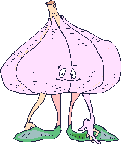
Garlic in India
The ancient Indians had varying views on garlic; but, for the most part,
it was considered to be highly beneficial to the body. Ancient Sanskrit
writings, dating as far back as 5,000 years ago, described the healing
properties of garlic. In fact, the ancient medical practice of Ayurveda,
which is still practised today, promoted garlic as one of the most
important herbs. It recommends garlic in over 100 formulations for
treating stomach, liver, tumor, asthma and other similar problems.

The Charaka Samhita is the oldest surviving Ayurvedic text, dating back to
200 BCE to 200 CE (AD), and suggests using garlic for alleviating:
- worms
- piles
- leukoderma
- leprosy
- epilepsy
- heart disease
- fainting
- arthritis
- rheumatism
- chronic rhinitis
- baldness.
It was also included in the diet of nursing mothers to encourage
milk secretion in nursing mothers and was hung to protect against evil spirits.
Other Ayurvedic teachings recommend garlic for:
- arteriosclerosis
- pain
- cholera
- dysentery
- indigestion
- constipation
- appetite loss
- fatigue
- typhoid
- tuberculosis
- cough
- fractures.
It is also advocated for i
mproving eyesight, intelligence, sexual debility, and
impotency.
On the other hand, the ancient Indians believed garlic was a natural
aphrodisiac that
inspired lust and stimulated passions and, as a result, holy men,
monks, widows, adolescents, and fasting persons were forbidden from
consuming garlic. In addition, it was considered to be rajasic food;
which meant it had unsettling effects on the body and devotees on the
path to spiritual enlightenment were advised against eating it. The
Buddists, Jains, Greeks and Romans also shared these sentiments;
however, some believe the mild irritation garlic caused in the
genitourinary tract may have resulted in its aphrodisiac and rajasic
status.








